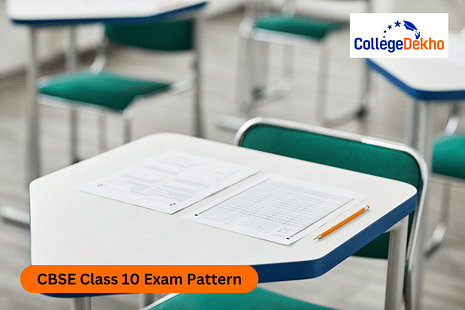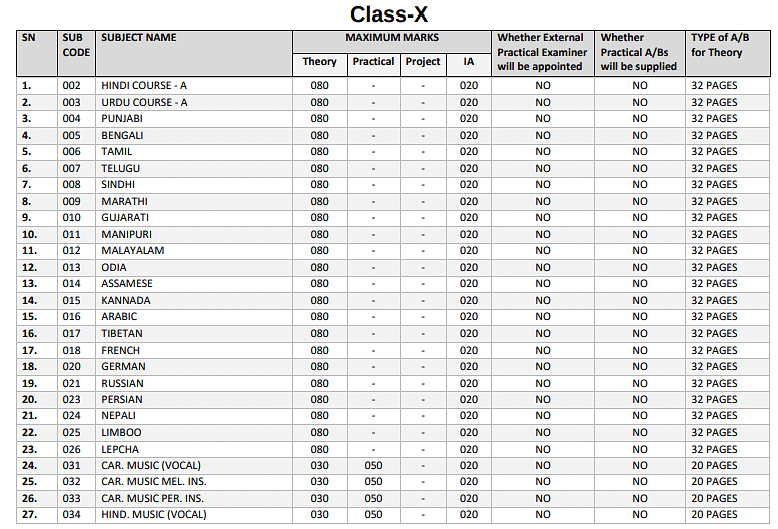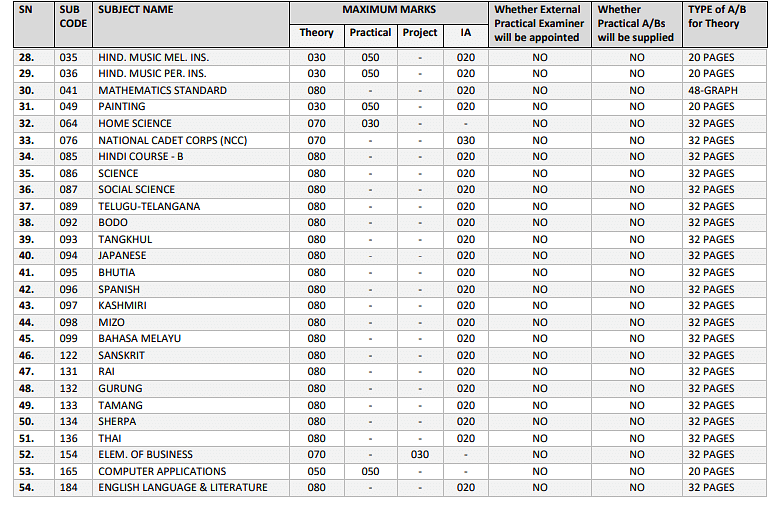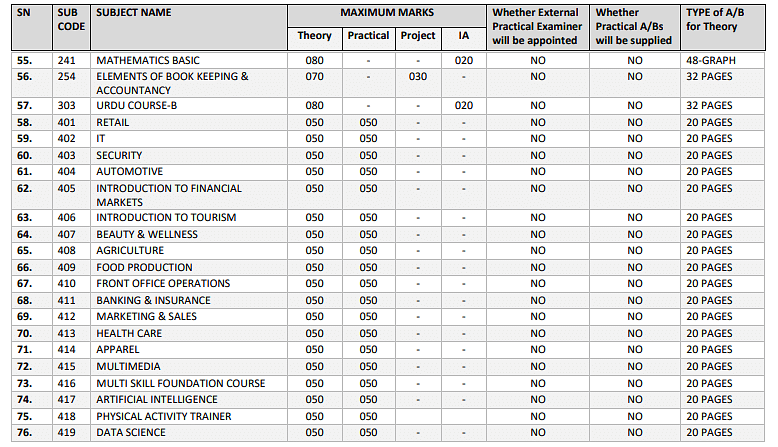- About CBSE Class 10 Exam Pattern 2024-25
- CBSE Class 10 Exam Pattern 2024-25: Overview
- CBSE Class 10 Blueprint 2024-25
- CBSE Class 10 Exam Pattern 2024-25 Subject Wise
- CBSE Class 10 Grading System 2025
- CBSE Class 10 Passing Marks 2025
- CBSE Class 10 Marking Scheme 2024-25
- CBSE Class 10 Exam Pattern 2024 For Internal Assessment
- CBSE Class 10 Important Books 2024-25
- CBSE Class 10 Preparations Tips 2024-25
- Faqs


Never Miss an Exam Update
About CBSE Class 10 Exam Pattern 2024-25
The Central Board of Secondary Education has now released the blueprints for every subject included in the curriculum on the official website. For class 10th, there are five compulsory subjects included in the curriculum followed by two optional subjects. In the five compulsory subjects, there are two languages and three other subjects including Mathematics, Social Science, and Science. According to the marking scheme followed by CBSE, the paper in every subject will be conducted for 100 marks including theory and practical exams. Usually, the theory paper is conducted for 80 marks.
According to the sources, no new changes will be recorded in the exam pattern for this academic year. In class 10th, around 50% of the questions will be based on competency according to last year's trends. The passing marks for class 10th are 33%. Students must score 33% marks together in theory and practical exams to pass. According to the latest notification released by CBSE, the board exams will start from 15th February 2025. The detailed CBSE Class 12 Date Sheet 2025 will be announced soon. Check more about the CBSE Class 10 Exam Pattern 2024-25 here:
CBSE Class 10 Exam Pattern 2024-25: Overview
Students can review some of the major highlights regarding the CBSE Class 10 Exam Pattern 2024-25 here:
| Parameters | Details |
|---|---|
Exam Mode | Offline |
Medium | Hindi & English |
Duration | 3 Hours |
Type of Questions | Multiple Choice, Competency-Based Questions, Long/Short Questions |
Compulsory Subjects | Language 1, Language 2, Mathematics, Science, Social Science |
Total Marks | 100 |
Negative Marking | No |
Theory Exam | 80 |
Internal Assessment | 20 |
Passing Marks | 33% Aggregate in Each Subject & Overall |
CBSE Class 10 Blueprint 2024-25
CBSE Class 10 Exam 2025 will be conducted in offline mode. The subjects that are included in CBSE 10th Exam Pattern 2024-25 are Language 1, Language 2, Mathematics, Science, Social Science, and 6th Additional Subject. The exam will be conducted for a total of 3 hours. The overall marks as per CBSE 10th Exam Pattern 2024-25 will be 100 marks (80 marks for theory paper and 20 marks for internal assessment). CBSE 10th exam will consist of different types of questions such as Multiple choice, competency-based, and long/ short answer questions. There will be no negative marking for incorrect answers.
The multiple-choice questions will have 4 options out of which the candidates will have to select one correct option. The competency-based questions will consist of a real-life scenario based on which analytical thinking questions will be asked. The long and short-answer questions will range from 1 mark to 5 marks. The question types and their weightage in the CBSE class 10th exam can be checked from the table below:
Question Type | Percentage |
|---|---|
Competency Focused Questions - MCQs/Case Based Questions, Source-based Integrated Questions, or any other type | 50% |
Select Response Type Questions - Multiple Choice Questions (MCQ) | 20% |
Constructed Response Questions - Short Answer/Long Answer type Questions (as per existing pattern) | 30% |
CBSE Class 10 Exam Pattern 2024-25 Subject Wise
Even though the overall CBSE 10th Exam Pattern 2024-25 will be the same for all the subjects, there are some minor specifications for each subject pattern. We will discuss in this section the subject-wise CBSE 10th Exam Pattern 2024-25 and their marking scheme:
CBSE Class 10 Exam Pattern 2024-25 for Mathematics
There are a total of 7 units included in the CBSE Class 10 Math Exam Pattern 2024-25 . Students can refer to the details exam pattern from the table given below. The same syllabus is followed by Mathematic Basics and Mathematics Standard:
Topics | Marks |
|---|---|
Number System | 6 |
Algebra | 20 |
Coordinate Geometry | 6 |
Geometry | 15 |
| Trigonometry | 12 |
Mensuration | 10 |
Statistics and Probability | 11 |
Total Marks | 80 |
Also Read: CBSE Class 10 Math Sample Paper 2024-25
CBSE Class 10 Exam Pattern 2024-25 for Science
A total of 5 units are included in the CBSE Class 10 Science Exam Pattern 2024-25 . Students can refer to the detailed information about the exam pattern from the table given below:
Topic | Marks |
|---|---|
Chemical Substances- Nature and Behavior | 25 |
World of Living | 25 |
Natural Phenomena | 12 |
Effects of Current | 13 |
Natural Resources | 5 |
Total Marks | 80 |
Also Read: CBSE Class 10 Science Sample Paper 2024-25
CBSE Class 10 Blueprint 2024-25 for Social Science
CBSE Class 10 Social Science Syllabus is divided into four parts with equal marks allotted to each of them. Students can refer to the detailed information about the same from the table given below. Check CBSE Class 10 Social Science Exam Pattern 2024-25
Subject | Syllabus | Marks | Percentage |
|---|---|---|---|
History | The Rise of Nationalism in Europe. Nationalism in India: The Making of a Global World Sub topics1 to 1.3 Print Culture and the Modern World Map pointing | 18 + 2 | 25% |
Political Science | Power – sharing Federalism Gender, Religion and Caste Political Parties Outcomes of Democracy | 20 | 25% |
Geography | Resources and Development Forest and Wildlife Resources Water Resources Agriculture Mineral& Energy resources Manufacturing industries. Lifelines of National Economy (map pointing) Map pointing | 17+3 | 25% |
Economics | Development Sectors of the Indian Economy Money and Credit Globalization and The Indian Economy Sub-topics: What is Globalization? Factors that have enabled Globalisation | 20 | 25% |
Total | - | 80 | 100% |
Also Read: CBSE Class 10 Social Science Sample Paper 2024-25
CBSE Class 10 Exam Pattern 2024-25 for English
As per CBSE Class 10 English Exam Pattern 2024-25 , the question paper will consist of a total of 11 questions which will be divided into 3 sections: Sections A, B, and C. The exam pattern and topic-wise weightage for class 10th English can be checked below:
Section | Number of questions | Total marks |
|---|---|---|
A: Reading | 2 | 20 |
B: Writing and Grammar | 5 | 20 |
C: Literature | 4 | 40 |
| Total | 80 | |
Also Read: CBSE Class 10 English Sample Paper 2024-25
CBSE Class 10 Grading System 2025
CBSE has introduced a grading system for class 10th which will be implemented in each subject. The grades will be provided to the candidates based on marks obtained in the board exam following a 9-point grading system. Grades will be awarded in each scholastic subject. For awarding the grades, the Board will put all the passed students in rank order and will award the grades as follows:
Grade | Awarded To | Marks Range |
|---|---|---|
A1 | Top 1/8th of the passed candidates | 91 - 100 |
A2 | Next 1/8th of the passed candidates | 81 - 90 |
B1 | Next 1/8th of the passed candidates | 71 - 80 |
B2 | Next 1/8th of the passed candidates | 61 - 70 |
C1 | Next 1/8th of the passed candidates | 51 - 60 |
C2 | Next 1/8th of the passed candidates | 41 - 50 |
D1 | Next 1/8th of the passed candidates | 31 - 40 |
D2 | Next 1/8th of the passed candidates | 21 - 30 |
E* | Essential Repeat | 0 - 20 |
Some of the major points regarding the CBSE Class 10 Grading System 2025 are listed below:
- In case of a tie, there will be some minor variations in the proportions of candidates.
- In case of a tie, all the students with the same score will get the same grade. However, if at any score points, there needs to be a division of 2 segments for the number of candidates, then the smaller segment will go with the larger segment.
- The grading method by CBSE will be used in the subjects where the number of candidates who have passed is more than 500.
- In respect of subjects where the total number of candidates passing a subject is less than 500, the grading would be adopted on the pattern of grading and distribution in other similar subjects.
CBSE Class 10 Passing Marks 2025
Students can refer to the passing marks required to pass the board exams from the table given below for both theory and practical exams:
Theory
Subjects | Maximum Marks | Passing Marks |
|---|---|---|
Social Science | 80 | 26 |
Science | 80 | 26 |
Other Regional and Foreign Languages | 80 | 26 |
Mathematics- Advance | 80 | 26 |
Mathematics - Basic | 80 | 26 |
English | 80 | 26 |
Computer Application | 30 | 10 |
Practical
Subjects | Maximum Marks for Internal Assessment/Practical Exams | Passing Marks for Internal Assessment/Practical Exams |
|---|---|---|
Social Science | 20 | 7 |
Science | 20 | 7 |
Other Regional and Foreign Languages | 20 | 7 |
Mathematics- Basic | 20 | 7 |
Mathematics- Advanced | 20 | 7 |
English | 20 | 7 |
Computer Applications | 70 | 23 |
CBSE Class 10 Marking Scheme 2024-25
It is also important to understand the marking scheme for CBSE 10th Exam Pattern 2024-25 to score higher marks in the board exams. Students can check the marking scheme for the CBSE 10th Exam Pattern from the table below:



- The overall exam will be conducted for a total of 100 marks.
- The theory exams will be conducted for a total of 80 marks.
- The internal assessment will be conducted for a total of 20 marks.
- The minimum passing mark for all the students is 33% aggregate overall. The students must score at least 33% aggregate in each subject to pass the exam.
- The internal assessment will consist of periodic tests for 10 marks, notebook submission for 5 marks, and Subject Enrichment Activity for 5 marks.
- There will be no negative marking.
CBSE Class 10 Exam Pattern 2024 For Internal Assessment
The internal assessment is a major benchmark for the class 10th exam as it will test the eligibility of the students to sit for the written exam. The internal assessment as per CBSE Class 10 exam pattern 2024-25 has been divided into multiple components such as:
Periodic Test | 5 Marks |
|---|---|
Multiple Assessment | 5 Marks |
Portfolio | 5 Marks |
Subject Enrichment Activity | 5 Marks |
Internal Assessment | 20 Marks |
CBSE Class 10 Important Books 2024-25
To prepare for the competitive nature of the class 10 board examination books will be the most essential and meaningful tools that applicants can rely on to prepare for their class 10 board examination 2024. Check out the table given below to learn more about the books:
Subjects | Books |
|---|---|
Mathematics | Secondary School Mathematics for Class 10 – R S Aggarwal All in One Mathematics – Arihant |
Science | Science for 10th Class: Physics by Lakhmir Singh and Manjit Kaur Principles of Physics: S Chand books, N. K Chowdhry Fundamentals of Physics: Pradeep Publication Science for 10th Class: Biology by Lakhmir Singh and Manjit Kaur Science for 10th Class: Chemistry by Lakhmir Singh and Manjit Kaur |
Social Science | All in One Social Science CBSE Class 10 – Arihant Golden Guide for Social Science – Sudha Rastogi, S.A. Siddiqui, J.P. Singhal & Dr. Gulshan Rai S Chand for Social Science – N.K Chowdhry Xam Idea for Social Science – Editorial Board |
English | English Communicative – Oswaal School Books CBSE All-in-One English Language & Literature Class 10 by Arihant Experts High School English Grammar and Composition Book by Wren and Martin for Grammar. Xam Idea Complete Course English for CBSE Class 10 by VK Global |
Hindi | Kshitij Kritika Sparsh Sanchayan |
CBSE Class 10 Preparations Tips 2024-25
There are some tips and tricks for class 10 students to prepare for the class 10th board examination for the CBSE. Check out the tips and tricks:
- Students should review the most recent curriculum and modify their preparation. If you're getting ready for a competitive exam, such as an entrance or scholarship test, you should go through the entire CBSE Class 10 Syllabus 2024-25 because these exams are held using the complete syllabus, however, there may be internal choices within the questions.
- The syllabus is just as crucial to know as the exam pattern. The curriculum is crucial for understanding the path to take, and the exam pattern aids in understanding how to proceed. The CBSE exam pattern includes essential components such as question types, exam duration, and marking schemes for both theory and practical exams.
- The planned study makes it easier to cover the topics in the allotted time. As a result, you should plan your study time to cover the syllabus. Here are some ideas for creating a study schedule: Include all subjects and allot time according to the importance of each subject and your level of learning, Include some time for hobbies and interests and take short breaks after 2 hours of studying to keep the mind fresh. Remove all distractions while studying such as smartphone notifications and music.
- Download and complete sample papers and question papers from previous years. Among all the CBSE Class 10 preparation tips for 2024, this is the most important. By completing these papers, you'll have an understanding of what to expect on exam day and learn the types of questions to expect. One or two questions from last year's exam may be asked in the board exam.
Also Read- CBSE Class 10 Result 2025
CBSE class 10 exam pattern 2024-25 is now officially updated on the official website of the Central Board of Secondary Education which the students can access. By taking into account the marking scheme, and topic-wise marks distribution, students should create their strategies based on their strengths and prepare themselves accordingly.





















